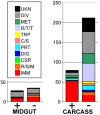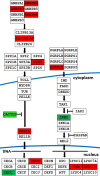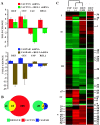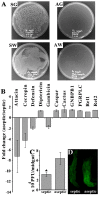The Aedes aegypti toll pathway controls dengue virus infection
- PMID: 18604274
- PMCID: PMC2435278
- DOI: 10.1371/journal.ppat.1000098
The Aedes aegypti toll pathway controls dengue virus infection
Abstract
Aedes aegypti, the mosquito vector of dengue viruses, utilizes its innate immune system to ward off a variety of pathogens, some of which can cause disease in humans. To date, the features of insects' innate immune defenses against viruses have mainly been studied in the fruit fly Drosophila melanogaster, which appears to utilize different immune pathways against different types of viruses, in addition to an RNA interference-based defense system. We have used the recently released whole-genome sequence of the Ae. aegypti mosquito, in combination with high-throughput gene expression and RNA interference (RNAi)-based reverse genetic analyses, to characterize its response to dengue virus infection in different body compartments. We have further addressed the impact of the mosquito's endogenous microbial flora on virus infection. Our findings indicate a significant role for the Toll pathway in regulating resistance to dengue virus, as indicated by an infection-responsive regulation and functional assessment of several Toll pathway-associated genes. We have also shown that the mosquito's natural microbiota play a role in modulating the dengue virus infection, possibly through basal-level stimulation of the Toll immune pathway.
Conflict of interest statement
The authors have declared that no competing interests exist.
Figures





References
-
- World Health Organization. Dengue and dengue haemorrhagic fever. 2008. Available: http://www.who.int/mediacentre/factsheets/fs117/en/. Accessed 10 June 2008.
-
- Halstead SB. Dengue Virus-Mosquito Interactions. Annu Rev Entomol 2007 - PubMed
-
- Holmes EC, Twiddy SS. The origin, emergence and evolutionary genetics of dengue virus. Infect Genet Evol. 2003;3:19–28. - PubMed
-
- Black WCt, Bennett KE, Gorrochotegui-Escalante N, Barillas-Mury CV, Fernandez-Salas I, et al. Flavivirus susceptibility in Aedes aegypti. Arch Med Res. 2002;33:379–388. - PubMed
Publication types
MeSH terms
Substances
Grants and funding
LinkOut - more resources
Full Text Sources
Other Literature Sources
Medical

